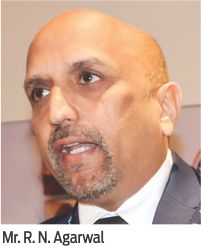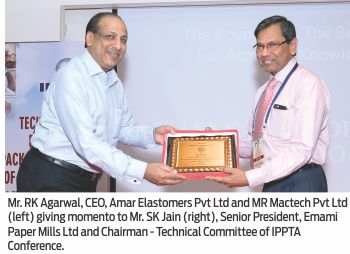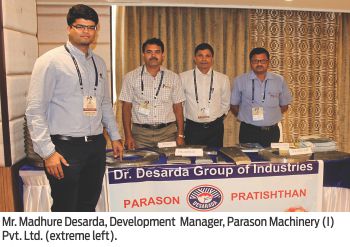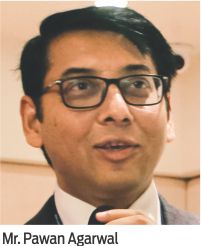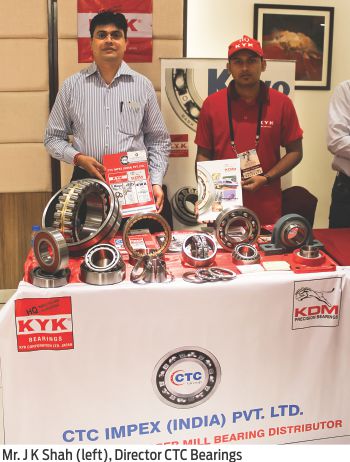The IPPTA’s seminar and technical conference with a major focus on packaging tried to put together an eclectic mix of discussions and technical presentations to cover technological, qualitative and commercial aspects of packaging evolving with time.
IPPTA’s conference on ‘Technological Development in the Field of Packaging Grades of Paper & Board’ was held on 26-27 November, 2016 in Vapi, Gujarat to create a platform for the exchange of ideas related to emerging trends, technologies, and major issues in the packaging segment of the Indian pulp and paper industry. The two-day long conference and seminar attracted a considerable gathering of speakers and audiences from a wide spectrum of the concerned segment.
In two days, the conference and seminar covered a panel discussion and four technical sessions covering themes as issues faced by kraft and board, packaging innovations, processes in corrugating technology, wet and functional process, emerging processes in packaging & board, etc. These sessions not only observed the major shifts in quality and technology aspects of the packaging area, but also suggested innovative solutions to some of the issues persistently faced therein.
The recycling of used Tetra Pak cartons and value addition, sustainable and functional packaging, the use of high RCT kraft paper for corrugated carton, etc. were some of the major subjects taken up for deliberation to the delight of the audience. Shifts towards high bulk packaging in the form of FBB/SBB and customers’ expectations from a packaging board were also discussed in different sessions.
Be Competitive to Survive
While delivering his keynote address, Mr. R. N. Agarwal, MD, NR Group of Industries gave an overall glimpse of present status of the industry and said that the paper industry is heading towards a robust future. “There will be challenges; but, as far as I see the growth of paper industry would be in tandem with the GDP growth of the country which would be around 6 to 7 percent,” he said.
He further said, “One has to be very competitive to survive in this difficult industry. The key word for success is efficiency. Vapi has got about 40 plus industries, if I am not mistaken, and most of the mills are doing very good. They are not only surviving, but they have competently faced the worst of the time and have never shut down. All this has been possible with the help of strong technical team and management. I am happy to be associated with a growing industrial set-up in Vapi.”
Mr. Agarwal also explained how technical efficiency of a paper mill provides it an edge over its competitors. “Major efficiency part in paper industry is productivity, the more good quality you achieve from good quality raw material and advance technology, the more it will make you viable and allow you to reduce cost and compete with best players. I think technical team is one of the major reasons because of whom we are doing reasonably well,” he said.
.
Talking on the efficacy of the technical seminar, he said, “The main agenda of this seminar is technical upgrades for packaging sector, in both paper and board. I foresee that there will be immense growth in packaging grade as compared to newsprint and W&P sector. e-Commerce and improvement in packaging of consumer goods will result in drastic increase in demand for packaging grade. Also, the government’s move of encouraging digital platforms for trading, purchasing and selling will also lead to increase in same. Around 90 percent of mills in Vapi are either producing kraft paper or duplex paper of mainly packaging grade; so, Vapi is lucky in a way that they have realized ahead of time that packaging grade would be the need of the hour. There will be new substantial investments coming up in packaging grades or value added grades of packaging also. We need to be selective about the right technology because future is to produce high quality product using right technology.”
Environment and procurement of waste paper also appeared importantly in his speech. “I would like to highlight two other major issues, one is environment and other is procurement because majority of mills in India are waste paper based. Paper industry is not considered environment-friendly because it consumes lots of energy and water; also, it discharges lots of water. But, with new improvements, most of the units in Vapi have achieved zero discharge,” he said.
“As far as power and steam are concerned, the paper industry requires high amounts of energy in terms of power and steam. We need to invest in technologies that aid us in reducing power consumption. Another major problem for paper industry is waste paper procurement. We are using 30 percent of imported paper and the rest 70 percent is still indigenous. However, the procurement scenario in India is not so good; we are not able to recover more than 20 to 30 percent of the paper which is produced. We should think of creative ways to procure waste paper so that paper industry can strengthen itself and reduce cost. We should constantly focus on 3Ps – Productivity, Participation and Planning for future,” he concluded.
Flexibility in Operations: Need of the Hour
Mr. Neehar Aggarwal, President, IPPTA, during his presidential address in the inaugural session of seminar said Vapi was the industrial town and paper hub of India. “It is very surprising to know that 1.5 million tonne of paper is coming from around 40 mills in Vapi, within India it is the highest paper producing town!” he added.
Mr. Aggarwal also said though India was the largest growing market for the paper in the world today, it was so in terms of growth, but not in terms of science. “Almost 20 percent of increase in the demand of paper will come from India and 60 percent would come from China. So, India represents very interesting market. Today, our capacities stand about 15-16 million and the consumption is about 13 kg per capita, which is quite low as compared to other developed countries in the world. Also, 1 kg per capita increase in consumption represents around 1.3 million tonne of production,” informed Mr. Agarwal.
Mr. Aggarwal also tried to see the silver lining in the demonetization phase for the paper industry owing to increased consumption of W&P paper at banks while doing transactions. “Due to demonetization when you go to banks toady amidst demonetization drive, you need to fill forms. If we calculate the amount of paper used, it would be somewhere around 50 thousand tonne. Even in this difficult situation, paper industry has more demand and paper makers in India can look forward to good times,” he said on an optimistic note.
Among major drivers for paper in India are robust GDP, a well-off middle-class, booming e-Commerce, etc. and all these drivers look healthy, Mr. Aggrawal said. “In W&P, we might feel some strain, but packaging industry would be doing extremely well in times ahead,” he added. Speaking on the easing raw material scenario, he said, “I used to buy wood at Rs. 11,000/tonne and today it costs me around Rs. 9,000/tonne. The raw material prices have come down and the imported pulp cost has also eased out, from USD 650 per tonne to USD 450 per tonne now. As a result, our input price have come down and, with the market’s support, our margins are improving.”
Mr. Aggarwal emphasized on the need to build flexibility in operations as far as kraft paper is concerned. “Because the market is changing and users want products that suit their requirements in terms of grammage, size, quantity and delivery period, we need to keep our operations flexible in order to serve our markets as per requirements,” he said. “Next major thing is new product development, especially in packaging. Here one can develop products for e-commerce, food, hygiene & healthcare, pharmaceuticals, etc. with endless product-type specifications. This will actually widen the product basket and create substitutes of products from other industries, e.g. plastic packaging may be replaced with paper-based packaging.”
“Other important factors are competiveness and efficiency, which play critical roles. We need to be efficient; we need to invest in new technologies; and we need to reduce our energy, water and chemical consumptions. Moreover, our procurement strategies have to be in place. In India, any paper machine for W&P is of 300 to 500 tonne per day, which is 1 or 2 lakh tonne annually. But, in China, they put up a machine of half a million tonne, indicating that we cannot compete with them on the basis of scale. But, we can definitely compete with them in innovation,” said Mr. Aggarwal. “Additionally, product quality and after-sales service is extremely important because repeat order will only come if our product quality is consistent and after sales service is good.”
“Another point is environment, and I am happy to know most of the mills in Vapi have zero liquid discharge. Also, for packaging industry the most important thing is to increase the yield of the waste paper because this industry is dependent on waste paper and in India rate of collecting waste paper is very low as compared to developed countries; the rate is just 20-25 percent in India whereas in USA collection rates are 60-65 percent and in Japan it is 70 percent. We are still dependent on paper coming from US and Europe. So, that is where the industry collectively needs to work on and take initiatives to improve the yields and to improve the technologies where the yield of waste paper goes up,” he added.
Productivity with Human Touch
Mr. Pawan Agarwal, Vice President, IPPTA, in his vote of thanks, said, “Opportunities arrive from the challenges; the tougher is the challenge, the bigger would be the opportunity. Demonetization has thrown lot of opportunities for the future. The biggest challenge with industries in Vapi is the localization of the markets, but then this challenge throws the opportunity.”
“We should try to understand particular requirements of the market. The need also is to see the requirements of other markets where we sell our products even if it involves higher transportation cost. We should try to understand our customers and then try to modify our set-up, technologies and our processes. As far as environment is concerned a lot needs to be done as we are quite behind the international standards,” he said.
“We need to deal with water conservation too in true sense and recycle more water. We can use various combinations of technologies to conserve water and IPPTA is planning to take certain initiatives in this field. Also, I would like to mention that productivity matters a lot, but it is not everything. Productivity with human touch is something needed in today’s time. So, we should try to develop and care about our HR department too which is often ignored,” he added.
Technical Sessions: A Roundup
In the presentation for the Tetra Pak recycling, it was concluded that the raw material could be easily slushed and had been found to be a good source of recycled fiber. There is a potential to use this raw material in blended material furnish to manufacture packaging grades of paper and boards. This recovered fiber is well suited to manufacture media kraft, liner kraft and liner boards.
A paper presented on ‘Advanced Dry Strength Chemistries for Packaging Grades’ dealt with the latest innovation in strength chemistries for paper and board with a focus on Kemira`s FennoBond Technology. The paper introduced the market and needs for strength chemicals and then compared a range of suitable strength chemistries with the technical and economic value they bring to the packaging producer. As conclusion, it was found that application of dry strength chemicals adds complexity; however, big improvements in the functionality and quality of the end product can be achieved.
In a case study for using ‘High RCT Kraft Paper for Corrugated Carton’, the conclusion was that imported waste paper refined in excess to develop maximum bursting strength, heavily coated by starch solution in size press to impart maximum RCT of the carton often leads to the problem of ‘cracking’ and ‘de-lamination’. The perfect paper with optimum refining controlled application of starch coating and maintaining the porosity and bulk of kraft paper solved such issues. The study showed that porosity of the test liner and flutings are very important to avoid cracking and de-lamination. Along with the porosity, the bulk of the paper also increases, reinforcing the compression.


